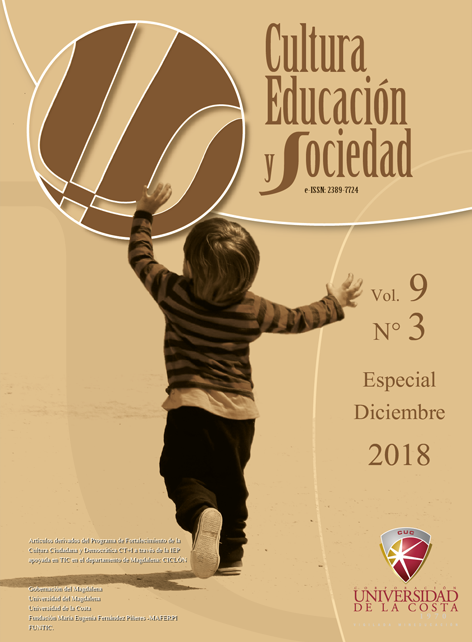Environmental education as a tool for the preservation of water resources
DOI:
https://doi.org/10.17981/cultedusoc.9.3.2018.56Keywords:
Environmental education, water sources, pollutionAbstract
Education requires an integration between the educational community and the environment, the pedagogical practice of educational institutions is nourished by the links established with the interests, needs and opportunities presented by students and the environment. In the corregimiento of San Juan de Palos Prieto, in Pueblo Viejo, the quality of the water sources is inadequate; This is why an environmental education and water quality evaluation program was set up in the school and the corregimiento. Through direct work with the communities it was possible to identify the uses, history and the main environmental problems, highlighting the misuse of the resource, by palm plantations. Through the project the formation and sensitization of the community in environmental terms was achieved, in order to improve and preserve the water sources close to the population, so that these can be of optimum quality for the multiple uses that are given at the domestic level and community
Downloads
References
Colciencias (2010) Libro “Actividades cartilla Los Navegantes De Las Fuentes Hídricas” – Programa Ondas. Colciencias, Bogotá.
Cortés, O. (2011). Comportamiento proambiental y pensamiento económico en la construcción del desarrollo sostenible. Cultura Educación y Sociedad, 2(1), 43-56.
Crissien-Borrero, T., Cortés-Peña, O., & Herrera-Mendoza, K. (2016). Pro-Environmental Assessment and Sustainable Consumption of Household Public Services in Barranquilla Colombia. The European Proceedings of Social & Behavioural Sciences – EpSBS, 17, 434-440. http://dx.doi.org/10.15405/epsbs.2016.11
Carrera, M; Bravo, O; Marín, F & Crasto, C (2013) Futuribles y Futurables para el Desarrollo Sostenible. Líder 22 (15), 39 -74
Díaz, C. (2000). Educación ambiental para el manejo adecuado y racional del recurso hídrico en el colegio san Víctor del Municipio de Supía Caldas (Tesis de pregrado). Universidad de Manizales.
Orellano, J. (2011). Instituto de Investigaciones Hidráulicas de la UNSJ. Una experiencia de gestión. Recuperado de: http://www.inv.lab_hidraulica.efn.uncor.edu/wp-content/uploads/2016/04/revista_CETA_1.pdf
Perdomo, A., y Cortez, T. (2014). Diseño de un proceso de educación ambiental para el buen provechamiento de las fuentes hídricas, a través de la resolución de problemas en el contexto escolar (Tesis de pregrado). Universidad del Valle
Rengifo, B., Quitiaquez, L., y Mora, F. (2012). La educación ambiental una estrategia pedagógica que contribuye a la solución de la problemática ambiental en Colombia. XII Coloquio internacional de Geocrítica
Torrecilla, J. M. (2006). La entrevista. Madrid, España: Universidad Autónoma de Madrid.
Downloads
Published
How to Cite
Issue
Section
License
Copyright (c) 2018 CULTURA EDUCACIÓN Y SOCIEDAD

This work is licensed under a Creative Commons Attribution-NonCommercial-NoDerivatives 4.0 International License.
![]()
Creative Commons 2020 CULTURA EDUCACIÓN Y SOCIEDAD
This article is under international license Creative Commons Reconocimiento-NoComercial-SinObrasDerivadas 4.0.
The published articles are the sole responsibility of their authors and do not necessarily reflect the opinions of the editorial committee.
CULTURA EDUCACIÓN Y SOCIEDAD respects the moral rights of its authors, who assign to the editorial committee the patrimonial rights of the published material. In turn, the authors inform that this work is unpublished and has not been previously published.
All articles are under a:
Licencia Creative Commons Atribución-NoComercial-SinDerivadas 4.0 Internacional.
![]()


 English
English
 Español (España)
Español (España)




_12.53_.27_p_. m_._3.png)





_12.57_.35_p_. m_._3.png)
_12.50_.37_p_. m_._3.png)



